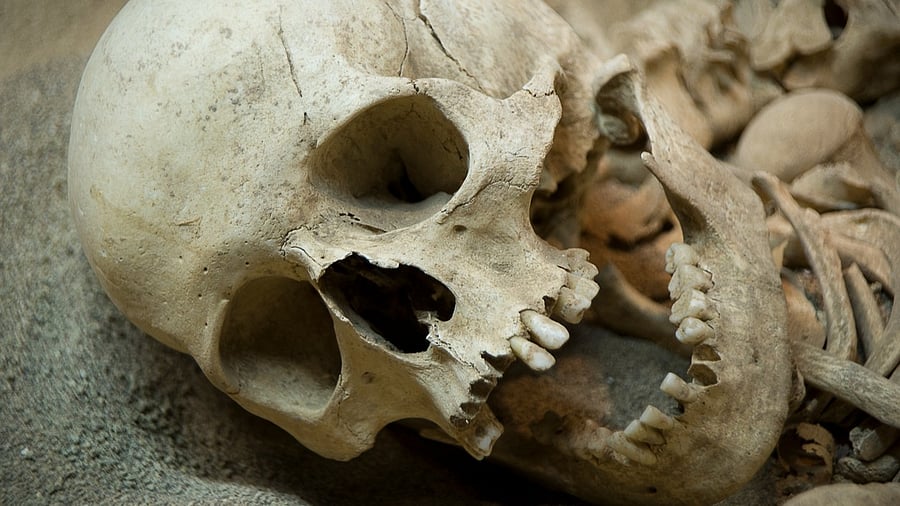
Image showing a human skull. For representational purposes.
Credit: iStock Photo
Archaeology, a field often associated with grand monuments and burial sites, has a more intimate storyteller: human teeth. Beyond their role in dietary studies, teeth bear marks of daily life, chronicling stress, occupational habits, and craft specialisation in ancient societies. Recent research underscores the significance of dental pathologies in reconstructing labour practices, offering unique insights into the division of work, social hierarchy, and even toxic exposure in pre-modern populations.
Dental tissues, being highly resistant to degradation, serve as enduring records of individual experiences. Unlike bones, which remodel over time, teeth retain evidence of stress and repetitive activity throughout life. Archaeologists and bioarchaeologists have leveraged these characteristics to explore past lifestyles, particularly focusing on how different occupations leave distinct marks on dentition.
Microscopic dental wear patterns, for instance, reveal dietary habits, but they also indicate exposure to materials used in specialised crafts. Enamel hypoplasia – characterised by grooves or pits on teeth – suggests physiological stress during childhood, often linked to malnutrition or disease. However, other dental conditions like excessive wear, abscesses, and alveolar bone loss are increasingly being linked to occupational activities rather than mere dietary factors.
The labour-intensive nature of ancient crafts often resulted in characteristic dental pathologies. Potters, for example, frequently suffered from enamel wear due to the constant exposure to abrasive clay particles. Similarly, textile workers, who used their teeth to hold and manipulate threads, exhibited high rates of alveolar bone loss and dental abscesses. Leatherworkers also developed unique wear patterns from using their teeth to soften hides, while metalworkers may have suffered from enamel degradation due to toxic exposure.
A striking example comes from medieval European populations, where higher rates of dental abscesses were observed among individuals engaged in textile production. The repetitive tension and clenching associated with thread-spinning likely contributed to this condition. Likewise, in ancient Egyptian mummies, severe dental wear suggests artisans used their teeth as tools, possibly for cutting or smoothing materials.
Among the Maya, scribes and artisans had intentionally modified teeth, including filing and notching, which not only reflected their occupational roles but also indicated social differentiation. Such evidence challenges the traditional notion that craft specialisation was solely determined by skeletal modifications, emphasising that dentition can provide an equally compelling narrative.
Archaeological studies across the globe have provided tangible evidence of these trends. In Central Europe, a Bronze Age site revealed that individuals engaged in pottery production displayed distinct enamel wear, indicative of prolonged exposure to gritty materials. Similarly, among medieval Scandinavian populations, individuals associated with textile work exhibited specific patterns of dental trauma linked to repetitive stress.
In a more extreme case, the skeletal remains of miners in ancient Rome showed severe enamel degradation, possibly caused by prolonged inhalation of toxic metal dust. This aligns with modern understandings of occupational hazards and reinforces the argument that ancient labour conditions could have had long-term health consequences.
Scientific advancements in dental analysis
Modern archaeological methods are refining our ability to interpret dental pathologies with unprecedented precision. Micro-computed tomography (Micro-CT) imaging, for instance, enables detailed assessments of enamel wear and microfractures, offering deeper insights into mechanical stress exerted on teeth. Stable isotope analysis helps differentiate between dietary and occupational influences on dental wear, providing a clearer picture of labour practices.
Geometric morphometric analysis – another cutting-edge tool – allows researchers to map surface changes in dentition over time, facilitating comparisons across different populations and craft specialisations. These technological advancements enhance the reliability of interpretations and reinforce the significance of dental studies in reconstructing ancient work environments.
The study of dental pathologies offers a fresh perspective on labour organisation in ancient societies. It challenges conventional interpretations of skeletal remains and expands the scope of archaeological inquiry beyond elite burials and monumental structures.
Teeth are more than just remnants of an individual’s diet; they are imprints of labour, stress, and survival strategies. The growing emphasis on dental pathologies in archaeology is redefining how we understand occupational health and craft specialisation in ancient societies. From potters to scribes, artisans to miners, the marks left on teeth serve as silent witnesses to the lived experiences of our ancestors. By continuing to refine these methods, we not only reconstruct past labour practices but also gain deeper insights into the resilience and adaptability of human societies through time.
(The writer is a PhD scholar at the Birbal Sahni Institute of Palaeosciences, Lucknow)
Disclaimer: The views expressed above are the author's own. They do not necessarily reflect the views of DH.